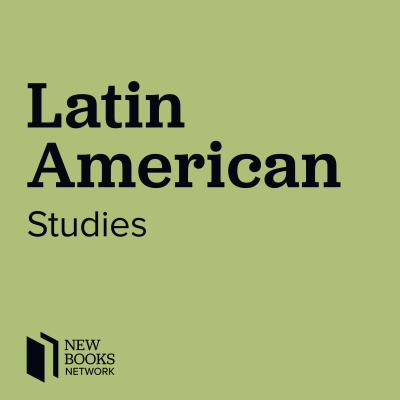Sinopsis
Interview with Scholars of Latin America about their New Books
Episodios
-
Daniel Altschuler and Javier Corrales, “The Promise of Participation” (Palgrave-MacMillan, 2014)
21/04/2014 Duración: 18minDaniel Altschuler and Javier Corrales are the authors of The Promise of Participation: Experiments in Participatory Governance in Honduras and Guatemala (Palgrave-MacMillan, 2014). Altschuler is a visiting scholar at the New School for Public Engagement, while Corrales is professor of political science at Amherst College. Participatory governance has long drawn the interest of scholars in political science. The promise of increasing civic engagement through institutions that allow citizens to participate has been studied extensively, but often in urban environments. Altschuler and Corrales build on this literature, but shift to rural parts of Honduras and Guatemala. The book focuses on Community Managed Schools and the participation of parents in school administration. They find that there were positive impacts on organizational learning and civic engagement for participating parents. You can view a short video from the book here.Learn more about your ad choices. Visit megaphone.fm/adchoices
-
Jason Ruiz, “Americans in the Treasure House: Travel to Porfirian Mexico and the Cultural Politics of Empire” (University of Texas Press, 2014)
11/04/2014 Duración: 58minIn Americans in the Treasure House: Travel to Porfirian Mexico and the Cultural Politics of Empire (University of Texas Press, 2014), Jason Ruiz explores the role of a distinct group of actors in the relationship between the United States and Mexico: American travelers, travel writers and photographers who visited and worked in Mexico during the late nineteenth and early twentieth centuries. With the junction of rail lines between the United States and Mexico in the 1880s, travel to Mexico became accessible to many in the populous U.S .East and Midwest. Through their photography and written accounts, These new travelers produced a popular representation of Mexico to the U.S. public which influenced both contemporary U.S. policy and modern U.S. attitudes towards Mexico. Drawing on the vast body of documentation and representation left by American travelers to Mexico, Ruiz argues that these travelers helped shape a form of U.S. cultural and economic imperialism distinct to Mexico. Travelers replicated many of t
-
Miranda Spieler, “Empire and Underworld: Captivity in French Guiana” (Harvard University Press, 2012)
28/03/2014 Duración: 55minIn Empire and Underworld: Captivity in French Guiana (Harvard University Press, 2012), historian Miranda Spieler tells of the transformation of a slave plantation colony into a destination for metropolitan convicts in the eight decades following the French Revolution. Unlike the better-known case of British Australia, French Guiana failed to turn...Learn more about your ad choices. Visit megaphone.fm/adchoices
-
Virginia Garrard-Burnett, Terror in the Land of the Holy Spirit (Oxford UP, 2011)
17/03/2014 Duración: 41minI have a colleague at Newman who takes students to Guatemala every summer. Since I arrived she’s encouraged me to join her. I would stay with the order of sisters who sponsor our university. I’d learn at least a few words of rudimentary Spanish. And, she says, if I’m really interested in genocide, I must visit this complicated, conflicted country. I’ve always declined (granted, I’m usually taking students to Europe, so I have a good excuse). However, after reading Virginia Garrard-Burnett’s excellent description of Guatemala in the early 1980s, I may have to say yes the next time. Burnett does an extraordinary job of making the complex politics of Guatemala understandable. Terror in the Land of the Holy Spirit: Guatemala under General Efrain Rios Montt 1982-1983 (Oxford University Press, 2011) is at least partly a biography of Rios Montt, and an excellent one. Burnett’s explanation of Rios Montt’s complicated personality and the influence religion played on
-
Jose Angel Hernandez, “Mexican American Colonization during the Nineteenth Century” (Cambridge UP, 2012)
06/03/2014 Duración: 01h21sAmericans talk a lot about the flow of Mexican immigrants across their southern border. To some that flow is seen as patently illegal and dangerous. To others it’s seen as unstoppable and essential for the functioning of the U.S. economy. Everyone agrees that something must be done about it though, in fact, little is ever done. It’s an American problem that seems to have no American solution. But, as Jose Angel Hernandez points out in his pathbreaking book Mexican American Colonization during the Nineteenth Century: A History of the U.S.-Mexico Borderlands(Cambridge University Press, 2012) , it’s not just an American problem: it’s also a Mexican one and always has been. In the wake of the Mexican American War (1846-48), the United States appropriated a huge chunk of what was Northern Mexico. This act of–what else can you call it?–naked imperialism left a lot of Mexican citizens stranded across the new border. The Mexican authorities might not have been able to get their ter
-
Thomas H. Guthrie, “Recognizing Heritage: The Politics of Multiculturalism in New Mexico” (University of Nebraska Press, 2013)
20/02/2014 Duración: 53minNew Mexico is a cultural borderland, marked by the interaction of Indian, Spanish, Mexican, and Anglo-American peoples over the past four hundred years. The question of how to commemorate this history and promote the traditions that arose from it is the subject of ongoing discussing, disagreement, and activism. In Recognizing Heritage: the Politics of Multiculturalism in New Mexico (University of Nebraska Press, 2013), Thomas H. Guthrie examines the work of scholars, community activists, politicians, and federal officials at several sites in Northern New Mexico – work meant to preserve the region’s Indian and Hispanic heritage and the state’s “multicultural” character, exemplified by the 2008 creation of the Northern Rio Grande National Heritage Area across the region. Recognizing Heritage offers a robust critique of the multicultural model at work in New Mexico. While Guthrie notes that both Anglo-Americans and Indian or Hispanic activists are well-meaning in their efforts to ma
-
Eduardo Kohn, “How Forests Think: Toward an Anthropology beyond the Human” (University of California Press, 2013)
09/02/2014 Duración: 01h10minWhen you open Eduardo Kohn‘s How Forests Think: Toward an Anthropology beyond the Human (University of California Press, 2013), you are entering a forest of dreams: the dreams of dogs and men, dreams about policemen and peccaries, dreams prophetic and dreams instrumental. In this brilliant new ethnography of a village in Ecuador’s Upper Amazon, those dreams are woven into the lives and deaths of a bookful of selves (both human and non-human) to help readers reconsider what it means to be a thinking, living being and why it matters to anthropology, science studies, and beyond. In creating this “anthropology beyond the human,” Kohn calls into question our tendency to conflate representation with language, rethinking the relationship between human language and other forms of representation that humans share with other beings. Here, human lives are both emergent from and contiguous with a wider semiotic community of were-jaguars and sphinxes, barking dogs and falling pigs, men and women al
-
Erica Cusi Wortham, “Indigenous Media in Mexico: Culture, Community, and the State” (Duke University Press, 2013)
14/01/2014 Duración: 44minVideography is a powerful tool for recording and representing aspects of human society and culture, and anthropologists have long used – and debated the use of – video as a tool to study indigenous and traditional peoples. Indigenous people themselves, however, have increasingly turn video towards their own cultural and communal ends, and this indigenous use of video raises its own questions: who in indigenous communities will control video production? How can video be integrated into indigenous life? And how should indigenous videomakers relate to state and institutional forces. In Indigenous Media in Mexico: Culture, Community, and the State (Duke University Press, 2013), Erica Cusi Wortham examines these issues in the case of “video indÃgena” in the Mexican states of Oaxaca and Chiapas during the 1990s. Indigenous Media in Mexico places video indÃgena into the historical context of 1990s Mexico, a period marked by both the constitutional recognition of indigenous groups as integ
-
Scott Ickes, “African-Brazilian Culture and Regional Identity in Bahia, Brazil” (University Press of Florida, 2013)
07/12/2013 Duración: 54minFrom the sounds of Samba to the spectacles of Carnival, Afro-Brazilian traditions are today seen as emblematic of Brazil and especially of Salvador de Bahia, the northeastern city where many Afro-Brazilian cultural traditions were first established. Salvador’s present status as the “Black Rome” of Brazil marks a shift from the early Twentieth Century, when Afro-Brazilian practices – particularly those associated with the religion Candomble – were denigrated as “primitive” and subject to repression in Bahia. Yet even as Afro-Brazilian culture is celebrated in Bahia and throughout Brazil, Afro-Brazilians themselves remain subject to discrimination, economic marginalization, and negative stereotypes, often directed at those same cultural traditions. In African-Brazilian Culture and Regional Identity in Bahia, Brazil(University Press of Florida, 2013), Scott Ickes explores the emergence of this paradoxical modern attitude towards Afro-Brazilian culture during and after th
-
Ioan Grillo, “El Narco: Inside Mexico’s Criminal Insurgency” (Bloomsbury, 2012)
19/08/2013 Duración: 40minToday I spoke to Ioan Grillo about his book El Narco: Inside Mexico’s Criminal Insurgency (Bloomsbury, 2012). This book is an excellent introduction to the state of conflict between drug cartels themselves, the government and the Mexican community. This is not an academic study of criminology. Ioan has reported from Mexico for many years and he has brought together his accumulated wisdom into this book. The final product provides the multi-dimensional story and analysis of the events in that country. He explains how external factors such as the war on drugs in Columbia and internal issues relating to the nature of governance in Mexico have influenced the current situation. But this is more than just a retelling of criminal activity. Ioan gives an insight into the social aspects of the drug culture including the glorification of the participants in popular music and the religious justifications used by some cartels. El Narco is a fascinating book that read to me like a sci-fi almost post-apocalyptic worl
-
Ron Schmidt (et al.), “Newcomers, Outsiders, and Insiders: Immigrants and the American Racial Politics in the Early 21st Century” (University of Michigan Press, 2013)
05/08/2013 Duración: 22minRon Schmidt is the co-author (with Yvette M. Alex-Assensoh, Andrew L. Aoki, and Rodney Hero) of Newcomers, Outsiders, and Insiders: Immigrants and the American Racial Politics in the Early 21st Century (University of Michigan Press, 2013). Schmidt is professor of political science at California State University Long Beach. This is a big book that covers long and complex histories of numerous groups in the United States. The authors link the arrival and integration of Latino Americans and Asian Americans to evolving group identities and developing political institutions. They draw interesting comparisons between the legacies of the African American social movements of the Civil Rights era and immigrant protests in other ethnic communities. They conclude with a mixed assessment about where the US now stands in terms of immigrant politics. Gains have been made, but immigrants remain largely shut out of traditional forms of political representation and often lack entre into politics.Learn more about your ad choic
-
Lance R. Blyth, “Chiricahua and Janos: Communities of Violence in the Southwestern Borderlands, 1680-1880” (Nebraska UP, 2012)
02/05/2013 Duración: 58minMost people today think of war–or really violence of any sort–as for the most part useless. It’s better, we say, just to talk things out or perhaps buy our enemies off. And that usually works. But what if you lived in a culture where fighting was an important part of social status and earning a living? What if, say, you couldn’t get married unless you had gone to war? What if, say, you couldn’t feed your family without raiding your enemies? Such was the case with Chiricahua Apache of the Southwest. As Lance R. Blyth shows in his terrific book Chirichahua and Janos: Communities of Violence in the Southwestern Borderlands, 1680-1880 (Nebraska UP, 2012), war was a necessary part of Chiricahua life, at least in the 17th and 18th centuries. They needed to fight the Spanish in Janos, and there was nothing the Spanish could really do to stop them, at least in the long term. Of course the Spanish–who were, it should be said, invaders–fought back. And so the two communities en
-
Paul Kan, “Cartels at War: Mexico’s Drug-Fueled Violence and the Threat to US National Security” (Potomac Books, 2012)
07/03/2013 Duración: 50minThe violence in Mexico is receiving a lot of media attention internationally. Paul Rexton Kan has produced a book that provides us with a comprehensive and comprehendible introduction to the background to the conflict and its effects. Cartels at War: Mexico’s Drug-Fueled Violence and the Threat to US National Security (Potomac Books, 2012) is a relatively short book packed with detailed information. The book covers the nature of the drug war, the cartels involved, the national and international responses and the effects of this war on the local and international communities. But this is not just a descriptive work. Kan provides us with his recommendations for solutions and predictions about the future of the conflict. In particular, he draws comparisons between treating this as an insurgency and spells out how a counter-terrorist response would not be the correct way to deal with the issue. This is high intensity crime and requires a high intensity policing response. Overall the book is an excellent int
-
Ilan Stavans and Steve Sheinkin, “El Iluminado: A Graphic Novel” (Basic Books, 2012)
14/12/2012 Duración: 57minAre you looking for a good Hanukkah gift? A good Christmas gift? Heck, any gift? Or maybe you just want to read a terrific book? Well I’ve got just the ticket: Ilan Stavans and Steve Sheinkin‘s, El Iluminado: A Graphic Novel (Basic Books, 2012). Stavans and Scheinkin team up to perform a minor miracle: they not only tell the story of hispanic crypto-Jews (conversos, marranos) in the Old and New Worlds, but they do it in the most entertaining, compelling way possible–with a great, moving, thought-provoking, and often funny (yes, funny) mystery. This is how popular history should be done. El Iluminado is–or should be–a model for all those scholars who want to bring their work to the public. I strongly urge you to take a look at the book and perhaps give it to someone you love.Learn more about your ad choices. Visit megaphone.fm/adchoices
-
Daniela Bleichmar, “Visible Empire: Botanical Expeditions and Visual Culture in the Hispanic Enlightenment” (University of Chicago Press, 2012)
26/11/2012 Duración: 01h06minDaniela Bleichmar‘s new book is a story about 12,000 images. In Visible Empire: Botanical Expeditions and Visual Culture in the Hispanic Enlightenment (University of Chicago Press, 2012), Bleichmar uses this vast (and gorgeous) archive of botanical images assembled by Spanish natural history expeditions to explore the connections between natural history, visual culture, and empire in the eighteenth century Hispanic world. In beautifully argued chapters, Bleichmar explores that ways that eighteenth century natural history expeditions were grounded in a visual epistemology where observation and representation were powerful tools for negotiating both scientific and imperial spheres. The “botanical reconquista” spanned fields, shops, gardens, and cabinets across the New World and the Old. Botanists, artists, and others employed images for collaboration and competition, developing distinct styles and practices for observing and representing the natural world. The expeditions’ taxonomic bota
-
Isaac Campos, “Home Grown: Marijuana and the Origins of Mexico’s War on Drugs” (UNC Press, 2012)
31/07/2012 Duración: 38minIsaac Campos is the author of Home Grown: Marijuana and the Origins of Mexico’s War on Drugs (University of North Carolina Press, 2012). Campos is an assistant professor of history at the University of Cincinnati. His book traces the intellectual history of marijuana from Europe to Mexico and the ways in which usage of the drug was portrayed – as a source of madness and violence — in the Mexican media. Campos turns on its head the popular myth that drug regulation in Mexico derives from US sources. For political scientists and for all those interested in the issue, the book offers a deep historical context for the current “war on drugs” and related violence in the US and in Mexico.Learn more about your ad choices. Visit megaphone.fm/adchoices
-
Ethelia Ruiz Medrano, “Mexico’s Indigenous Communities: Their Lands and Histories, 1500-2010” (University of Colorado Press, 2010)
17/10/2011 Duración: 01h01minIn my work with pre-Hispanic and colonial Mexican pictorial texts, I often wish I could talk with the people who authored them. In the academic setting, sometimes we forget that these documents represent conversations about what was happening in the lives of many people at the time they were created and that some aspects of these materials that we have found in archives or ancient cities are still part of the cultural heritage and daily lives of the descendants of the creators. Ethelia Ruiz Medrano helps us realize that the study of popular culture also can mean the sharing of knowledge. Ruiz Medrano’s research in the tiny town of Santa Maria Cuquila has led to a new way of thinking about our pasts and how they connect with our presents. Ruiz Medrano’s book Mexico’s Indigenous Communities: Their Lands and Histories, 1500-2010 is a best-selling work on popular culture from the University of Colorado Press. Indigenous Communities traces a new context for our Amerindian heritage. Ruiz Medrano e
-
Ethelia Ruiz Medrano, "Mexico's Indigenous Communities: Their Lands and Histories, 1500-2010" (U Colorado Press, 2010)
17/10/2011 Duración: 01h02minIn my work with pre-Hispanic and colonial Mexican pictorial texts, I often wish I could talk with the people who authored them. In the academic setting, sometimes we forget that these documents represent conversations about what was happening in the lives of many people at the time they were created and that some aspects of these materials that we have found in archives or ancient cities are still part of the cultural heritage and daily lives of the descendants of the creators. Ethelia Ruiz Medrano helps us realize that the study of popular culture also can mean the sharing of knowledge. Ruiz Medrano's research in the tiny town of Santa Maria Cuquila has led to a new way of thinking about our pasts and how they connect with our presents. Ruiz Medrano's book Mexico's Indigenous Communities: Their Lands and Histories, 1500-2010 is a best-selling work on popular culture from the University of Colorado Press. Indigenous Communities traces a new context for our Amerindian heritage. Ruiz Medrano examines local admi
-
Joel Wolfe, “Autos and Progress: The Brazilian Search for Modernity” (Oxford UP, 2010)
19/03/2010 Duración: 01h05minHere’s something I learned by reading Joel Wolfe’s terrific Autos and Progress: The Brazilian Search for Modernity (Oxford, 2010): the United States and Brazil have a lot in common. Both hived off European empires; both struggled with slavery and its legacy; both are profoundly multiethnic and multiracial; both have spent much of their respective histories settling a vast “wild” frontier (though, to be fair, it was already “settled” by indigenous people); and, most importantly for our purposes, both are car-crazy, and indeed for almost the same reason. In the United States, the automobile meant modernity. It was the implement with which we, Americans of every stripe, would “tame” a continent and thereby realize our national potential. The Brazilians, according to Wolfe, feel the same way. Joel does a masterful job of explaining how the promise of this crucial technology entered the Brazilian psyche and became not only the vehicle of modernity (pardon the pun) bu
-
William Beezley, “Mexicans in Revolution, 1910-1946” (University of Nebraska Press, 2009)
08/05/2009 Duración: 01h05minIt’s shocking and embarrassing how little I, as an American, know about Mexican history. Mexico shares a 2,000 mile long border with the United States. Mexico is America’s third largest trading partner (behind Canada–about which I also know nothing–and China). Over 20 million people in the U.S. say they are of “Mexican descent.” But all I can tell you about Mexican history is that the Aztecs built some really impressive pyramids, then the Spanish took over, then the Mexicans threw the Spanish out, then “we” beat the Mexicans and grabbed a bunch of their territory, then there was a confusing period involving France, and then Pancho Villa and Emiliano Zapata did some revolutionary stuff. The only phrase that comes to mind when I think of the period that followed–1910 to the present–is “illegal aliens.” My ignorance is just pathetic (not to mention irresponsible). So I was really happy when William H. Beezley told me that he and Colin M. Mac
































